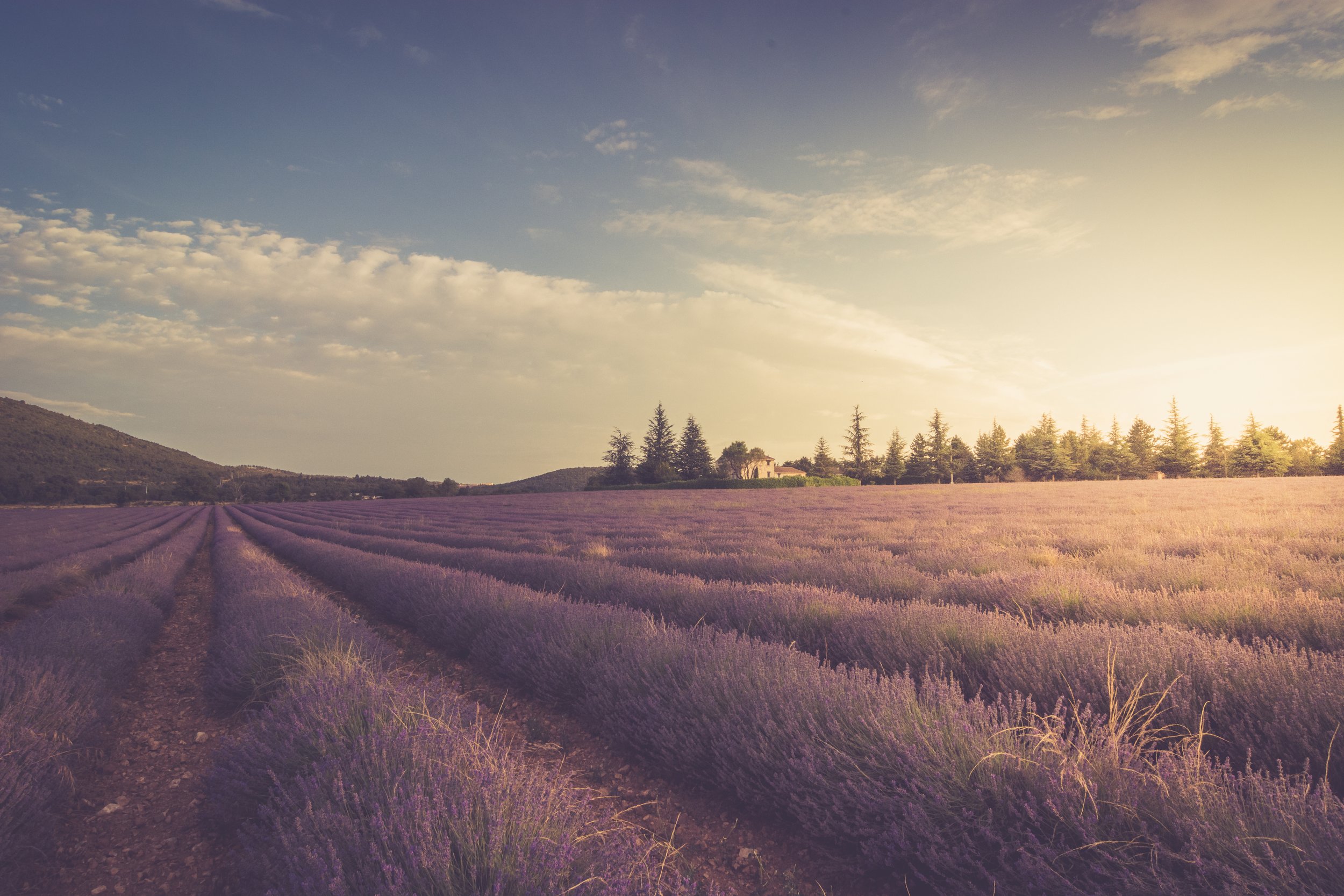Lavender Fields
If you ever happen to find yourself in the South of France in the summer, the lavender fields are a definite “Must See.” Bring your camera, pack a picnic, and be prepared for the scent, sight, and sound of a lifetime.
Lavender - the intoxicating smell encompasses everything around. It has long been on my bucket list to visit a lavender field in full bloom.
Late one afternoon, armed with a dog-eared travel guide, a wishful Pinterest board, and a map, we hit the highway in search of purple.
The first field we found had about a dozen different groups of people spread out among the rows of brightly blooming flowers. They must have the same travel guide. Nearly all had cameras – some were posing for family photos, some for model shots, or some for Instagram fame. All were reveling in the amazing sight, smell, and sounds of the field.
As we left the main highway and meandered along smaller roads (aka some paved, some gravel) we left the crowds and found empty fields. Happy bees buzzed loudly. We had packed a picnic and as the sun began to set, we dined with lavender fields on all sides.
The South of France is arguably the best place in the world to find thousands of acres of beautiful, breathtaking lavender fields. The rocky, well-drained soil makes the perfect growing environment. The typical blooming and harvest season is from mid-July through mid-August. It was late July so some of the fields had already been harvested. Lavender harvest is similar to cutting hay, leaving crisp green rows where the vibrant purple lavender blooms had been.
During our quests for the most beautiful lavender fields, we stopped at small seasonal stores to talk with local farmers. These pop-up markets had lavender-everything: essential oils, sachets, foods, and bunches of fresh blooms.
If you ever happen to find yourself in the South of France in the summer, the lavender fields are a definite “Must See.” Some of the top places to find lavender fields include:
· Terre UGO in Aix-en-Provence
· Plateau of Valensole
· Plateau of Claparedes
· Village of Sault
· Route de Manosque
· Luberon Villages - Gordes and Saignon
Bring your camera, pack a picnic, and be prepared for the scent, sight, and sound of a lifetime.
Written for Sonder Travel Magazine Edition 4
Market Days
On Tuesday (Mardi), Thursday (Jeudi), and Saturday (Samedi) the town becomes a party of textiles, handcrafts, antiques, food, and flowers. Buses, cars, and Vespas may speed around the sculptural Fountaine de la Rotonde, but the sidewalks are all reserved for vendors and inspectors of their goods.
We hit up the market with a short list of items to find: lavender soap, straw hat, handmade cutting board, and lunch.
The Aix Markets (Marche’s D’Aix) host dazzling displays of colors, textures, and scents. A variety of old-style markets are held daily. The city of Aix-en-Provence, often shortened to simply Aix, pronounced like the letter “X” is located on the edge of the Cote d’Azur.
Vendors line up their wares on both sides of the tree-lined Cours Mirabeau. Aptly named one of the most beautiful avenues in the world, on market days this Provincial place bursts with energy and commerce.
On Tuesday (Mardi), Thursday (Jeudi), and Saturday (Samedi) the town becomes a party of textiles, handcrafts, antiques, food, and flowers. Buses, cars, and Vespas may speed around the sculptural Fountaine de la Rotonde, but the sidewalks are all reserved for vendors and inspectors of their goods.
The fish and food market can be found daily at the Place Richelme. Fresh seafood is brought in from nearby boats in the Mediterranean coastal towns of Marseilles and Cassis. Shrimp, fish, mussels, and octopus are kept on ice to go straight from the market to your kitchen.
Colorful fruits and vegetables dominate the main food market. Red, yellow, and purple tomatoes are stacked beside braided knots of garlic longer than a man’s forearm. Fresh cantaloupe, berries, and apricots are piled among every color of food imaginable. Buckets and bowls of fresh spices, imported from around the world, are sold by weight. But smelling them all is free of charge.
Aix-en-Provence was once the capital of Provence. Nearly 45,000 international students add a youthful energy to the town from the university that dates from 1409. Aix is also known as the City of A Thousand Fountains because of the dozens of fountains that punctuate nearly every street corner. The café’ laced maze of narrow streets make the perfect place for two of our favorite activities - shopping and people watching.
Successful in our market haul, we were inspired to stop on the way back at one of the sidewalk cafés. We got the plat du jour. I am pretty sure the ingredients for the chicken curry came from the daily market just a block away.
Written for Sonder Travel Magazine Edition 4














